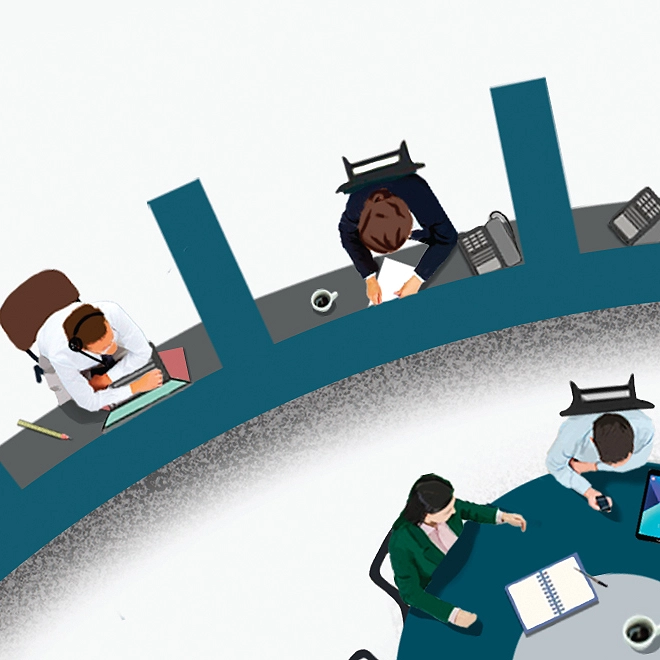If these walls could talk
Getting the workplace of tomorrow right
—Abhishek Ratna
OPEN-PLAN offices. Natural lighting. Ellipticals in the break room. Many enterprises have been going “all in” when it comes to work environment redesign, investing heavily in remodeled workspaces in the hope of realizing a host of benefits: better talent attraction and retention, improved collaboration, greater creativity, higher productivity … and the list goes on and on. But as some firms have discovered, cashing in on those benefits isn’t always as simple as breaking down walls, eliminating private offices, and installing skylights. Some organizations that were enthusiastic early adopters are now discovering unforeseen downsides or unrealized benefits from their investments—and wondering whether the problems can be fixed (and if so, how difficult that would be).1
What can organizations do to address issues with their current workspace, or transform it properly the first time around? Drawing upon behavioral science theory and organizational literature, this article explores why problems have sometimes occurred despite positive leadership intentions and careful planning. We leave readers with practical guidelines to consider for how organizations can go about rethinking and redesigning their workplaces to remediate current issues and avoid future missteps.
Looking back: What’s changed?
Before delving into current trends in workplace redesign, it’s informative to take a step back and look at how the workforce, and work itself, has evolved—in ways that have perhaps shaped the changes taking place in the physical workspace. One obvious difference is that, looking back to the 1970s and even early 1980s, computers and digital technology in general were essentially absent from most people’s day-to-day work.2 Not only has technology transformed work in myriad ways, but it has also, in many cases, eliminated the need to come to a set physical location to get work done. With this decoupling of work and location has come the ability for most enterprises to cast a broader net for workers and talent, sourcing workers from more-distant locales. This has contributed to an increase in workforce population diversity. Today’s workforce is more culturally and geographically diverse than that of 50 years ago, in part due to technology’s reach, but also due to greater workforce participation among women as well as changing overall demographics.3 Additionally, workplace norms regarding hours and attire have shifted. It is no longer a given that workers will work from nine to five, Monday through Friday. Hours have become more flexible, as have workforce contracts, with more part-time, gig, contract, and freelance workers entering the labor pool.4 What one wears to work has also changed—even for organizations such as those on Wall Street, where at one time wearing anything but suit-and-tie business attire was unthinkable.5
Keeping the workplace current: Open layouts versus cubicles
Given these changes in what work is and how and where it is done, and the concurrent evolution in the workforce’s desires and needs, it’s not surprising that enterprises have felt the need to look critically at their workplaces to identify how they might best evolve to meet the needs of both the work and the worker.
One of the most widespread changes occurring at workplaces around the world has been the creation of open office spaces. According to one study, 68 percent of people in 2010 worked in an office with either no or low walls—“and that number has undoubtedly grown,” deadpans a Fast Company article published in early 2019.6 But has this been a positive trend?
One aim of an open-plan office is to facilitate colleague contact and collaboration—and thereby improve productivity.7 However, contrary to prior hypotheses, recent research suggests that most employees are neither fans of these types of offices,8 nor necessarily accomplishing the goals of greater collaboration and productivity in them. In fact, one study of the interactions between colleagues at two multinational companies that had recently switched to open-plan layouts found that the open floor plans had the exact opposite effect. At one company’s open-plan office, the volume of face-to-face interactions decreased by more than 70 percent from what it had been in the old, cubicle-based office. Ironically, what did increase was the number of emails and instant messages people sent; their frequency increased by 56 percent, even when the correspondents could clearly see each other across the room. The findings were similar at the second company, with face-to-face interactions decreasing by two-thirds after the office moved to an open floor plan, and email increasing by between 22 percent and 50 percent. What’s more, for at least one of the companies, productivity after the switch to an open office layout declined.9
The study authors explained these findings by positing that employees, valuing their privacy, used technologies such as email to find new ways to preserve it in these open-plan offices.10 But email isn’t the only way to preserve one’s privacy in an open office. We’ve often observed, at offices with open layouts, workers wearing large headphones or earbuds to keep out the distractions caused by nearby colleagues or foot traffic in the area—and possibly signal to others that they don’t want to be disturbed.
Cubicles—the common alternative to an open-plan layout—are often not viewed as a great work environment either, though some have contrasted them with open-plan offices as the lesser evil.11 While cubicles might be viewed as a “happy medium” solution between private offices and open-plan layouts, they have their downsides. Compared with offices, they are typically noisier—and compared with open-plan layouts, they often cut off workers from natural light. However, cubicles do give workers an opportunity to give their work area a personal touch with pictures, awards, personal mementos, and the like.12 Thus, people are able to give their cubicle space its own (or their own) personality, making their cubicle an extension of themselves. This bringing of one’s “authentic self” to work has been found to be beneficial, not just to the worker’s personal happiness, but also to his or her output, as workers who are able to let their authentic self shine through are typically more productive—and, over time, more successful.13
However, putting a personal touch on one’s environment becomes much harder, if not impossible, when firms move away from permanent cubicle assignment toward either hoteling—reserving a desk or workstation space in advance of use—or hot desking—where workspaces are available on a first-come, first-served basis.14 It’s worth noting in this regard that 30 percent of multinational firms now use hot desking, with 45 percent of multinational enterprises planning to implement it by 2020.15 Given that the average office worker spends eight hours a day at work, one might raise the question of whether forcing people to forego workplace personalization might have detrimental effects on workers.
It’s not just about privacy: Supply, demand, and optics
Adaptable offices—spaces, furniture, tools, and technologies that are easily reconfigurable depending on the need or demand—are not a perfect answer, either. Neither are hoteling or hot desking, whether for cubicles or for workstations in an open office. Offices that adopt these strategies need to get several things right. First, they need to align supply and demand (for example, how many people will need quiet spaces to finish work under tight deadlines, and how many will need conference rooms for meetings and collaboration?). Second, regarding hoteling,16 what is the process for reserving these rooms? Is it first-come, first-served? If so, how can companies discourage bogarting—people reserving rooms “just in case”? And if there is a limited supply, who is given priority? Who isn’t?
Company leaders also need to understand the messages their layout and space reservation processes send. Do they signal that some employees are more important than others? Hot desking, for example, can make employees feel as if they are disposable cogs in a machine. When offices employ a two-tiered system in which higher-level employees are given offices while more junior employees are not, behavioral economics theory17 reveals that this sends a clear message to those without offices, not only that they are less important, but that others are more important than them. These feelings of negativity are only exacerbated on days when employees who don’t have offices need a private (or conference-sized) space and nothing is available, while many offices assigned to higher-level workers are unoccupied. In such situations, hot desking can potentially deliver a triple whammy to employees’ psyches—making them feel unimportant to leadership in an absolute sense, less valued than others in a relative sense, and frustrated by their firm’s inability to manage resources to provide them with the office configuration they need to best perform their duties.
Uncovering the most common pitfalls
So why have well-intentioned office redesign plans often underperformed? Based on organizational and behavioral literature and our own observations, below are three common pitfalls many companies encounter when redesigning office spaces.
Pitfall No. 1: Making quick decisions or treating workplace transformation as a one-and-done activity. Recent Deloitte research has highlighted how easy it can be for some organizational leaders to be lured by “shiny new objects.”18 While we applaud firms that are open to incorporating new amenities, configurations, and formats, leaders should be careful before making quick short-term workspace redesign decisions based on fads, such as installing treadmills or café-style coffee areas. Because fads often change, leaders should track the success of such alterations and ensure that they could be easily reversed if proven ineffective. In general, too, leaders should avoid designs that are too “fixed,” such as partitions that cannot be easily moved or meeting rooms that cannot be easily reconfigured.
Ideally, workplace redesign should be a continual, ongoing process, not a single-point-in-time change. However, if a firm cannot afford to make frequent workplace investments, they should consider either making any changes minor, or taking the time to make a more educated decision, such as determining the likelihood of something being a fad or a longer-term trend. For instance, companies could consider factors such as an innovation’s compatibility with existing routines, work habits, and infrastructure; its flexibility or ability to be personalized; its relative advantage over existing office amenities or formats; and its adoption among similar or dissimilar groups or subcultures—all of which can help leaders discriminate between short-lived crazes and more enduring phenomena.19
Pitfall No. 2: Failing to incorporate diverse stakeholder input. In their enthusiasm to create a better workplace environment, some leaders may forget to collect input before and throughout the process, or only seek input from a subset of people who will be using the space. Of course, full-time employees who will be working in the office every day should be offered the opportunity to give feedback on its future design. But if the workplace is designed to encourage virtual workers to visit the office more frequently or offer gig or contract workers a place to work, leaders should seek input from these groups as well. And if client meetings will occur regularly in the new space, leaders should also seek client input. Further, with the growth of multicultural workforces in global organizations, cultural and subcultural differences in terms of work style and norms should be understood and accounted for when planning and designing spaces.
Pitfall No. 3: Failing to clearly articulate the features and benefits of new workspaces. As with all change and execution strategies, getting to the desired outcome is not just about having an implementation strategy; leaders need an accurate messaging strategy, too, to communicate internally and externally about a new office setup and what the company is trying to accomplish by making the changes. Some of the best-laid plans fall flat because plans and intentions were not clearly articulated or were out of line with the hoped-for result. At many firms, it isn’t clear to employees how they are supposed to behave or use the space as it was intended. And when employees are confused about how to use the new space, teams often tend to “hack” spaces to revert to the way that they were working in their old office.
Guidelines for effective workplace redesign
How can organizations move forward in a positive manner and avoid these common pitfalls? Below are some steps leaders can take in the planning stages to help ensure redesign intentions become workplace realities.
- Prioritize design choices based on the reasons people come into the office. People come into the office for many different reasons (figure 1). Every workplace environment serves different purposes for a variety of stakeholders. For employees, the office is where they do their own work, but it’s also a place where they collaborate, socialize, and network. For an organization’s recruiting executives and client-facing executives, the office can also serve as a branding tool, a magnet to help attract talent or close deals. Which of these reasons for being there are the most important and should therefore be weighted more heavily? Is it possible to find an approach that will satisfy different needs equally well? To answer questions like these, leaders’ No. 1 priority and first step should be to understand why people are currently and could be coming into the office. They can then factor all these reasons into their decisions about how to configure the space.
- Communicate the workplace redesign strategy, plans, and progress. Once leaders set in place a workplace redesign strategy, they should complement it with a messaging or communication strategy for both internal and external stakeholders. These communications should explain the rollout plan, detailing the changes, process, and benefits. Stakeholders will likely appreciate being informed about these details; just as customers do, employees value authenticity and transparency.20 This also enables leaders to set and manage expectations.
- Develop an ongoing data collection and measurement strategy. Workplace redesign is meant to serve the needs of stakeholders and should be iterative, not a “one and done” process—an evolution versus a revolution. A workplace redesign strategy should include methods to measure what is working and where additional tweaks or revisions (or even reversions to the prior state) may be necessary. Data can be collected in several ways, such as conducting user satisfaction surveys, observing traffic flow, and doing interviews with different stakeholders. Companies can also let the walls do the talking by incorporating sensors and other technologies to track real-time data on user behavior. This can help leaders gauge the effort required to use the space and identify common pain points,21 which can help uncover areas that may need to be refined or changed.
- Use incentives to encourage trials and build new habits. Just because you build it doesn’t mean they will come. Leaders should consider strategies and incentives to encourage trials of new office space formats for employees already in the office. If part of the redesign strategy is to encourage remote workers to come back into the building, leaders could offer incentives such as paying for office parking for commuters, or even counting commute time as “time on the clock.” Also, since people learn by observation and are likely to emulate those above them, leaders could ask senior managers to work in new open spaces or host team meetings in these spaces.

The walls do talk—and say a great deal
Just as a picture speaks a thousand words, so does an enterprise’s physical space. Office spaces reveal where and how various workers of different functions and levels work, and the processes for reserving these spaces give insights into an organization’s culture, values, and history. The design and function of an organization’s offices also shed light on how much (or how little) an organization’s leadership values different stakeholders. Hence, office environments can greatly reinforce—or greatly weaken—an enterprise’s purported values and culture. Additionally, offices can have either a motivating or demotivating effect on those who work or visit there. With this in mind, leaders should ensure that workplace culture and physical workplace design are aligned, remembering that the workplace is there to support the work and workforce, not the other way around.
Embarking on a workplace redesign effort can be a tremendous opportunity for leaders to subtly but clearly communicate their firm’s story, history, values, culture, talent objectives, and outlook on their future. For organizations that get it right, what their walls have to say will be music to their—and their stakeholders’—ears.
Human Capital
Today’s business challenges present a new wave of HR, talent, and organization priorities. Deloitte’s Human Capital services leverage research, analytics, and industry insights to help design and execute critical programs from business driven HR to innovative talent, leadership, and change programs.
Learn more

